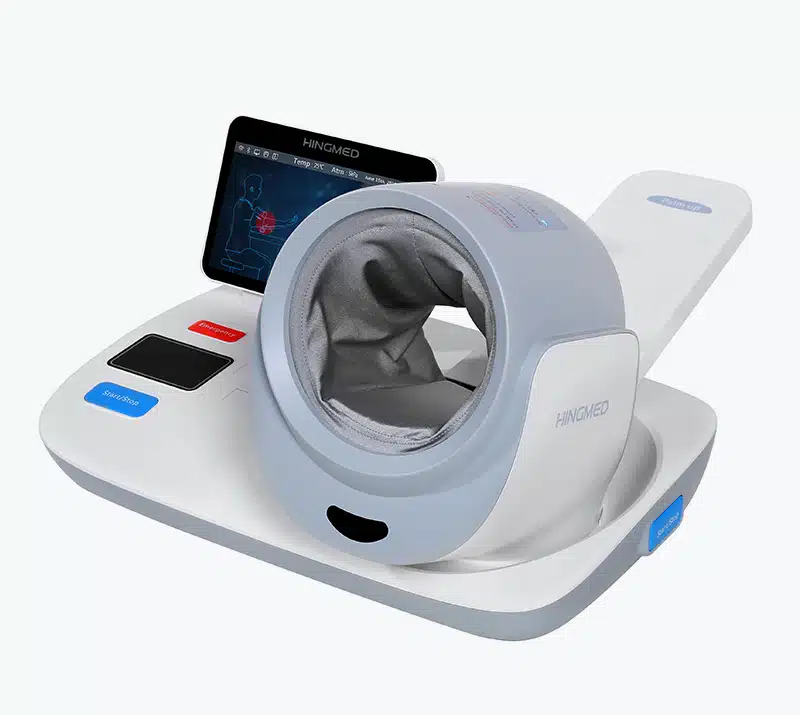Blood pressure kiosks have become an essential tool for those who need to monitor their blood pressure regularly. These devices are user-friendly and widely accessible, making it easier for individuals to keep track of their health. Among the various models available, the Hingmed blood pressure kiosk stands out for its accuracy and ease of use. In this article, we’ll explore how to use a blood pressure kiosk effectively, with a specific focus on the Hingmed blood pressure kiosk.
Understanding Blood Pressure Kiosks
Before diving into the step-by-step guide on using a blood pressure kiosk, it’s important to understand what these devices are and why they are valuable. A blood pressure kiosk is an automated machine designed to measure your blood pressure without the need for a healthcare professional. These kiosks are commonly found in pharmacies, supermarkets, clinics, and even workplaces.
The kiosk typically consists of a chair, an arm cuff, a display screen, and a computerized system that processes the readings. The kiosk inflates the cuff around your arm, measures the systolic and diastolic blood pressure, and displays the results on the screen within minutes. Some advanced kiosks, like the Hingmed blood pressure kiosk, offer additional features such as heart rate monitoring and data storage, which can be useful for tracking your health over time.
The Importance of Regular Blood Pressure Monitoring
Regular blood pressure monitoring is crucial for maintaining good health. High blood pressure, or hypertension, is often called the “silent killer” because it usually has no symptoms but can lead to serious health problems like heart disease, stroke, and kidney failure. By regularly checking your blood pressure, you can detect any changes early and take steps to manage your health effectively.
The convenience of blood pressure kiosks makes it easier for people to monitor their blood pressure regularly. Instead of needing to visit a doctor or clinic, you can simply stop by a kiosk during your daily routine. This accessibility encourages more frequent checks, which can lead to better health outcomes.
How to Use a Hingmed Blood Pressure Kiosk
Using a Hingmed blood pressure kiosk is straightforward, but there are a few steps you should follow to ensure an accurate reading. Here’s a comprehensive guide on how to use the kiosk effectively:
- Locate a Hingmed Blood Pressure Kiosk
The first step is to find a Hingmed blood pressure kiosk near you. These kiosks are often located in pharmacies, hospitals, community centers, and other public spaces. Some workplaces and gyms may also have them installed for the convenience of employees and members. You can usually find the nearest kiosk by checking the Hingmed website or asking at local healthcare facilities. - Prepare for the Measurement
Before using the kiosk, it’s important to prepare yourself for the measurement to ensure the most accurate reading. Here are some tips:- Rest for a Few Minutes: Sit quietly and rest for at least five minutes before taking your measurement. Avoid any physical activity, such as walking or climbing stairs, right before using the kiosk, as this can temporarily raise your blood pressure.
- Avoid Caffeine and Smoking: Refrain from consuming caffeine or smoking for at least 30 minutes before the measurement, as both can increase blood pressure.
- Empty Your Bladder: A full bladder can affect the accuracy of your blood pressure reading, so it’s a good idea to use the restroom before using the kiosk.
- Wear Appropriate Clothing: Ensure that your clothing is not too tight around your arm, as this can interfere with the cuff’s ability to measure your blood pressure correctly. If necessary, roll up your sleeve or remove any constrictive clothing.
- Sit Properly in the Kiosk
Proper positioning is crucial for an accurate blood pressure reading. When you sit in the Hingmed blood pressure kiosk, follow these guidelines:- Sit Upright: Sit in the chair provided by the kiosk with your back supported and your feet flat on the floor. Avoid crossing your legs, as this can affect the reading.
- Position Your Arm Correctly: Place your left arm (or the arm specified by the kiosk) into the cuff. Your arm should be at heart level, resting comfortably on the armrest provided by the kiosk. The cuff should be placed on your bare arm, with the lower edge of the cuff about an inch above your elbow.
- Relax Your Arm: Keep your arm relaxed and still during the measurement. Tensing your muscles or moving your arm can cause an inaccurate reading.
- Follow the On-Screen Instructions
The Hingmed blood pressure kiosk is designed to be user-friendly, with clear instructions provided on the screen. Once you’re seated and positioned correctly, follow these steps:- Start the Measurement: Press the start button on the kiosk’s screen. The machine will automatically inflate the cuff around your arm and begin measuring your blood pressure.
- Stay Still and Quiet: It’s important to remain still and quiet during the measurement. Moving, talking, or even laughing can affect the accuracy of the reading.
- Wait for the Results: The kiosk will display your blood pressure reading on the screen after a few moments. It will show your systolic pressure (the top number), diastolic pressure (the bottom number), and sometimes your heart rate.
- Understand Your Results
Once the measurement is complete, the Hingmed blood pressure kiosk will display your results on the screen. Understanding these numbers is key to monitoring your health:- Systolic Pressure: This is the top number and represents the pressure in your arteries when your heart beats. A normal systolic reading is typically between 90 and 120 mmHg.
- Diastolic Pressure: This is the bottom number and represents the pressure in your arteries when your heart is at rest between beats. A normal diastolic reading is typically between 60 and 80 mmHg.
- Heart Rate: Some kiosks also display your heart rate, measured in beats per minute (BPM). A normal resting heart rate for adults is typically between 60 and 100 BPM.
- If your reading falls within the normal range, it indicates that your blood pressure is healthy. However, if your reading is higher or lower than normal, it may be a sign that you need to consult a healthcare provider. It’s important to note that a single high reading does not necessarily mean you have hypertension, but consistent high readings over time may require medical attention.
- Record Your Results
Keeping a record of your blood pressure readings can help you and your healthcare provider track changes over time. The Hingmed blood pressure kiosk may offer options to print your results, send them to your smartphone via an app, or email them to yourself. If these options are available, take advantage of them to maintain a log of your readings.- Use a Health App: Some users prefer to use a health app to track their readings digitally. If the Hingmed kiosk is compatible with health apps, you can easily sync your results for future reference.
- Manual Recording: If the kiosk doesn’t have digital options, you can manually record your readings in a notebook or on a smartphone. Be sure to include the date and time of each reading.
- Follow Up as Needed
Regular monitoring is key to managing your blood pressure, but it’s also important to follow up with a healthcare provider if you notice any concerning trends. If you consistently get readings that are higher or lower than normal, or if you experience symptoms such as dizziness, chest pain, or shortness of breath, schedule an appointment with your doctor.- Consult Your Doctor: Bring your recorded blood pressure readings to your doctor’s appointment. This information can help your doctor assess your condition and determine if any changes to your treatment plan are needed.
- Lifestyle Adjustments: Based on your readings, your doctor may recommend lifestyle changes such as a healthier diet, regular exercise, stress management techniques, or medication. Following these recommendations can help you maintain a healthy blood pressure.
Features of the Hingmed Blood Pressure Kiosk
The Hingmed blood pressure kiosk is known for its advanced features, which make it a preferred choice for both individuals and healthcare providers. Here are some of the key features that set it apart:
- Accurate and Reliable Measurements
Accuracy is the most important factor when it comes to blood pressure monitoring, and the Hingmed blood pressure kiosk is designed to provide precise readings. The machine is calibrated to ensure that each measurement reflects your true blood pressure, reducing the risk of false readings. - User-Friendly Interface
The kiosk’s interface is intuitive and easy to navigate, even for those who may not be familiar with medical devices. The on-screen instructions guide users through each step of the process, making it simple to obtain an accurate reading. - Data Management Capabilities
The Hingmed blood pressure kiosk offers advanced data management features, allowing users to store, retrieve, and share their readings easily. This is particularly useful for individuals who need to monitor their blood pressure regularly or share their results with a healthcare provider. - Accessibility Features
The kiosk is designed to be accessible to a wide range of users, including those with mobility issues. The chair is adjustable, and the arm cuff is designed to fit different arm sizes, ensuring that everyone can use the kiosk comfortably. - Compact and Portable Design
Despite its advanced features, the Hingmed blood pressure kiosk is compact and portable. This makes it easy to install in various locations, from pharmacies and clinics to corporate offices and fitness centers. - Additional Health Monitoring
In addition to blood pressure readings, the Hingmed kiosk may offer other health monitoring features such as heart rate measurement and BMI calculation. These additional features provide users with a more comprehensive understanding of their health.
The Importance of Using the Hingmed Blood Pressure Kiosk Correctly
While the Hingmed blood pressure kiosk is designed for ease of use, it’s essential to follow the correct procedures to ensure the most accurate and reliable readings. Misusing the kiosk, such as by not sitting properly or not following the preparatory steps, can lead to inaccurate results, which might mislead you about your health status. Here’s why each step matters:
- Proper Positioning: Your body position during the measurement is crucial because even minor deviations can impact the reading. For instance, if your arm is too high or too low, relative to your heart, it can falsely elevate or lower your blood pressure reading. Ensuring that your arm is at heart level and that you’re sitting upright with your feet flat on the floor is essential for getting a true reflection of your blood pressure.
- Stillness During Measurement: Any movement, talking, or tensing of muscles can interfere with the reading. The Hingmed blood pressure kiosk is sensitive enough to detect minor disturbances, which is why it’s important to remain as still as possible until the measurement is complete.
- Consistent Monitoring: Using the Hingmed blood pressure kiosk consistently, following the same steps each time, is important for tracking your blood pressure trends over time. Variations in your routine or environment can lead to inconsistent readings, which may complicate your ability to monitor your blood pressure accurately.
- Understanding and Using the Results: The data provided by the Hingmed blood pressure kiosk is only as useful as your understanding and application of it. Knowing what the numbers mean and how they apply to your health is key to making informed decisions. It’s important not to panic if a single reading is higher than normal; instead, look for trends over time or consult a healthcare provider for further advice.
Advantages of the Hingmed Blood Pressure Kiosk for Different Users
The Hingmed blood pressure kiosk is beneficial for a wide range of users, including individuals, healthcare providers, and organizations. Here’s how different groups can benefit from this advanced device:
- For Individuals:
- Convenience: Individuals can use the Hingmed kiosk without the need for a doctor’s appointment. This convenience encourages more frequent monitoring, which is particularly beneficial for those with hypertension or other health conditions that require regular blood pressure checks.
- Privacy: Unlike a visit to the doctor, using a kiosk provides a private and stress-free environment. Some people may experience “white coat syndrome,” where their blood pressure rises due to anxiety in a clinical setting. A kiosk can help avoid this, leading to more accurate readings.
- For Healthcare Providers:
- Patient Monitoring: Healthcare providers can use the data from the Hingmed blood pressure kiosk to monitor their patients’ blood pressure between visits. This allows for more proactive management of conditions like hypertension.
- Data Integration: The kiosk’s ability to store and share data makes it easier for providers to integrate blood pressure readings into a patient’s medical records, improving the continuity of care.
- For Organizations:
- Employee Health: Workplaces can install the Hingmed blood pressure kiosk to promote health and wellness among employees. Regular monitoring can help detect potential health issues early, leading to better employee health and productivity.
- Community Health Initiatives: Community centers, gyms, and other public spaces can use the Hingmed kiosk as part of broader health initiatives, encouraging the public to take charge of their health.
Troubleshooting Common Issues with the Hingmed Blood Pressure Kiosk
While the Hingmed blood pressure kiosk is designed to be reliable and easy to use, there may be times when you encounter issues. Here’s a guide to troubleshooting some common problems:
- Error Messages:
- Cause: Error messages on the kiosk might appear due to improper cuff placement, movement during measurement, or issues with the machine itself.
- Solution: Ensure the cuff is placed correctly, stay still during the measurement, and try again. If the error persists, check if the kiosk is connected to power and functioning properly, or seek assistance from on-site staff.
- Inconsistent Readings:
- Cause: Inconsistent readings can result from variations in your body position, stress levels, or recent physical activity.
- Solution: Follow the recommended steps for preparation and positioning, and try to measure your blood pressure at the same time of day to reduce variability. If inconsistencies persist, consult a healthcare provider.
- Cuff Size Issues:
- Cause: The kiosk cuff might not fit properly if you have larger or smaller arms.
- Solution: Most Hingmed kiosks have adjustable cuffs, but if the fit isn’t right, consider using a different kiosk or seeking a manual blood pressure measurement from a healthcare provider.
The Future of Blood Pressure Monitoring with Hingmed
As technology continues to evolve, so too will the capabilities of blood pressure kiosks like those from Hingmed. Future advancements may include more personalized monitoring, integration with wearable devices, and enhanced data analytics to provide users with even more insights into their health.
- Personalized Monitoring: Future kiosks may be able to adjust settings based on individual user profiles, taking into account personal health data and providing more customized health advice.
- Integration with Wearable Devices: As wearable health technology becomes more prevalent, future kiosks could sync with devices like smartwatches to offer a more comprehensive view of a user’s cardiovascular health.
- Enhanced Data Analytics: With more sophisticated data analysis tools, future blood pressure kiosks could provide users with predictive analytics, warning them of potential health issues before they become serious.
- Remote Healthcare: As telemedicine grows, kiosks may play a vital role in remote patient monitoring, allowing healthcare providers to receive and analyze data in real-time, regardless of the patient’s location.
Conclusion
The Hingmed blood pressure kiosk represents a significant advancement in the accessibility and ease of blood pressure monitoring. By following the correct steps to use the kiosk, you can obtain accurate readings that help you monitor your health effectively. Whether you’re an individual looking to manage your health, a healthcare provider seeking to improve patient care, or an organization aiming to promote wellness, the Hingmed blood pressure kiosk offers a valuable tool for better health outcomes. As technology continues to advance, the future of blood pressure monitoring looks even more promising, with more personalized, integrated, and predictive capabilities on the horizon.
Keep an eye for more news & updates on Gossips!




